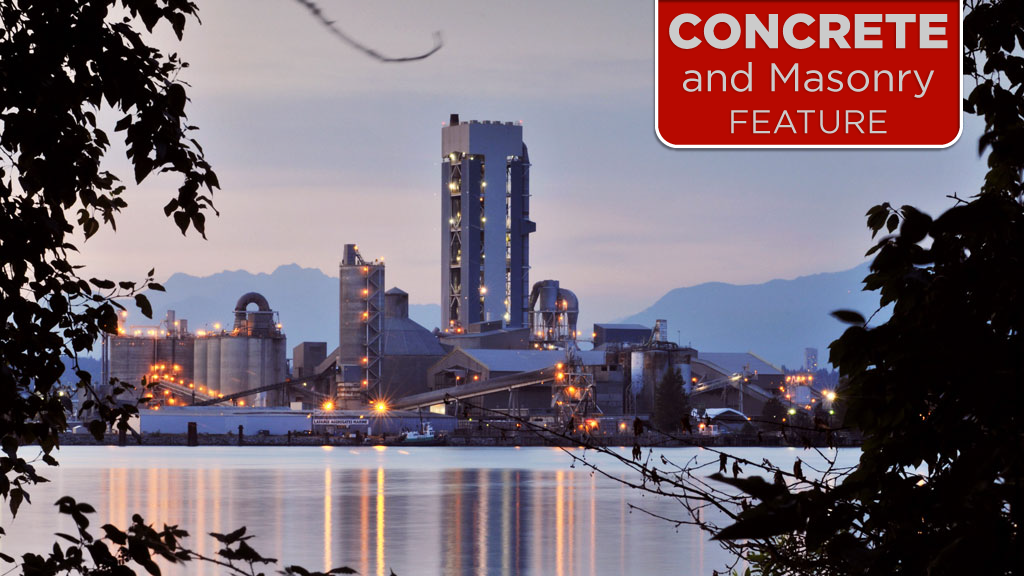Despite the challenges caused by COVID-19, a first-of-its-kind pilot project to capture industrial levels of CO2emissions from the Lafarge Canada cement plant in Richmond, B.C., has reached a major milestone.
The transformative project, called CO2MENT, is part of the company’s drive to make Richmond the most carbon-efficient cement plant in Canada and could dramatically change the cement and concrete industry.
Carbon-capture technology developed by Svante Inc. has been installed at the plant to trap CO2 produced from the industrial processes. The technology enables the cement facility to capture the CO2 contained in the cement flue gas and to reuse it for CO2-cured concrete, thus storing it permanently.
Svante offers companies in emissions-intensive industries a commercially viable way to capture large-scale CO2 emissions from existing infrastructure, either for safe storage or to be recycled for further industrial use in a closed-loop. Total, a company committed to cleaner and innovative energy, is also involved in the project.
Coupling the Svante equipment with alternative fuels used at the plant creates the world’s first full-cycle solution to capture and reuse CO2 from a cement plant and lead the way to a near-zero emissions cement facility.
“Lafarge sees tremendous value in partnering with clean technology companies to solve the challenges of today for a better tomorrow,” says Cailee Ellis, head of sustainability and environment – Western Canada for Lafarge Canada Inc. “Our partnership with Svante has been critical in achieving our carbon capture, utilization and storage goals at Richmond and supporting Holcim on its path to net-zero.
“At Lafarge, climate and energy is one of our primary sustainability pillars. We are already applying the learning from the pilot and de-risking of Svante’s technologies at other Lafarge assets to advance our net-zero goals.”
Flue gas from the plant’s manufacturing facility is now captured through Svante’s equipment – reducing the amount of greenhouse gases released into the atmosphere. The system purifies the cement flue gas by trapping its contaminants to enable an efficient and durable CO2 capture process. The next step is to figure out ways to use the captured CO2 such as reinjecting it into low-carbon fuels, concrete and fly ash.
That work is slated to take place over the next three years and will include the installation of a liquefaction unit and the development of an expansion project to further reduce emissions.
The process has not been implemented in a cement plant anywhere else in the world. The success of the Lafarge project could cause a major shift in the manufacturing of cement in Canada and around the world.
Phase one of the multi-phase project has been completed and entailed pre-treating the flue gas, making it suitable for Svante’s carbon capture technology.
The project is now in phase two, which entails separating the CO2 from the flue gas through Svante’s carbon capture technology.
As the project advances to phase three, Lafarge is working with Svante to identify feasible uses for the captured CO2 and consider liquefaction of the CO2. The third phase is scheduled for the next three years and will include the installation of a unit to liquefy the gas and the development of an expansion project to further reduce emissions, as well as putting together a business case for further expansion across the Lafarge network.
Project CO2MENT provides an opportunity to evaluate the potential for a new business model for supplying industrial post-combustion CO2 to the existing CO2 market as well as assessing the economic feasibility of newly developed CO2-use technologies.
Ellis says that having Svante on the site has increased efficiency of the technology and created co-benefits for respective teams to learn more about each other’s processes and the benefits of the technology.
“Having the technology on-site ensures that we are learning together. Government funding and the role of public investment has been a tremendous support in advancing investment into this project and ultimately the technology.”
Brad Kohl, president and CEO of Lafarge Western Canada, said in a statement that it’s been a turbulent year for business and people due to the COVID-19 pandemic. with many large-scale projects being put on hold, but the perseverance of people working at the Richmond Cement plant is evident in the success of the project.
“To continue leading change in the building materials industry means we are always looking to partner with like-minded thought leaders such as Svante and Total. This partnership is showcasing our drive towards a net-zero future, and we are seeing this vision become a reality, right now with the completion of this phase.”
Claude Letourneau, president and CEO of Svante, said there has been work on energy efficiencies and renewables, but no major developments on capturing and cost-effectively using CO₂ emissions from industrial sources, until now.
“The last piece of this problem is essential because it is the part that allows us to transition to a carbon-neutral marketplace. Our partnership with Lafarge is building a new net-zero economy, and that is a very positive message we are sending to the world – it can be done.”











Fully on board with aspirations. Wishing for success. I am curious how the business case could be made without knowing the end market uses precisely enough to evaluate cost and income derived from marketing Co2.